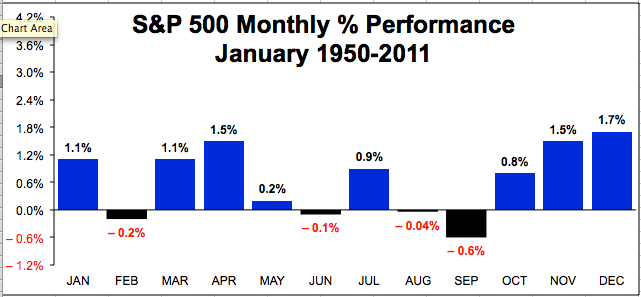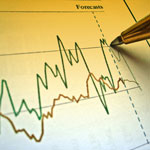all markets in correction mode
looking and analyzing trend line - support line - cycles projections
extreme caution needed when entering a position
watching the market very closely..
the pennyshares seems to run..
many stocks approaching top of cycle
will sell into the momentum
MISSION ACCOMPLISHED for 2011
DISTRIBUTION TIME ?????
Commentary: While Tuesday's( firts week january ) down day in the markets was relatively tame as far as the major indexes were concerned, many former market leaders suffered a high volume selloff. Even though one distribution day isn’t usually enough to change the overall trend in a stock, it does shock current market participants and will likely have a residual effect moving forward. Often when a stock suffers a violent down day, the low will act as a resistance level as worried market participants begin to sell on any bounces back into the selloff day's price range.
Why the Bullish Forecasts for 2011 Might Hit a Few Snags
The Dow has advanced for seven consecutive weeks, but has gained only about 100 points per week during that timeframe. So the recent price action does not feel over-the-top exuberant. Instead, it feels steady, reliable…almost predictable.
Everyone knows the market will go up next week, just like it went up last week…and the week before that. This seeming predictability is simply a different strain of irrational exuberance. When the market seems as soothing as a Corona Beer commercial, the “fear instinct” goes dormant. Investors forget to worry.
But a Corona beer commercial isn’t reality. And neither is a tranquil, friendly stock market.
Nevertheless, most Wall Street strategists have been falling all over one another to proclaim their bullish forecasts for 2011. Goldman Sachs strategist, David Kostin, is looking for a 17% rally in the S&P 500 Index this year, while most of his Wall Street counterparts are expecting at least low double-digit gains.
We hope these hopeful prognostications come to fruition. In general, up is much better than down. But it’s a long year ahead and the road to gains may not be as direct and “predictable” as the Dow’s recent performance might suggest.
The market might encounter a few bumps along the way. In fact, David Rosenberg, economist for Canada’s Gluskin Sheff, expects the market to encounter a few bumps very soon. “Signs of excessive exuberance abound,” says Rosenberg.
In particular:
- The VIX index, at 17.5x, is back to where it was last April. Remember what happened next.
- Investors Intelligence bullish sentiment is back to where it was at the all-time market highs of October 2007.
- The non-commercial accounts on the CME have recently opened up a considerable net speculative long position in equities, particularly the QQQ’s (NASDAQ stocks).
- Market leadership is narrowing, as Bob Farrell has been busy pointing out.
- The number of short-selling positions slid 2.2% in the first half of December on the NYSE; and by 2.8% on the NASDAQ. The bears are running scared.
- As Kelly Evans asserted last week, the AAII investor sentiment poll has been above its historical norm now for 17 weeks running – the longest stretch in six years.
- Since July, margin debt has exploded by 16% to $274 billion, the most since September 2008 when people still thought we were in a soft landing.
- Equity mutual funds and ETF’s took in $24 billion in December (TrimTabs data)… The last time we saw retail inflows like this into equities was last March…just ahead of a 17% correction.
Eric Fry
for The Daily Reckoning
Read more: Why the Bullish Forecasts for 2011 Might Hit a Few Snags http://dailyreckoning.com/why-the-bullish-forecasts-for-2011-might-hit-a-few-snags/#ixzz1AjKXmQvj
PREDICTIONS 2011
The investment banking powerhouse sees the S&P 500 (INDEX: .SPX) gaining nearly 25 percent to a level of 1450 in the next 12 months, fueled by strong corporate profits, easy monetary policies and an improving U.S. economy.
Goldman (NYSE:GS - News) sees stocks gaining as the U.S. economic growth accelerating from 2.5 to 4 percent by the end of 2012, but says investors will continue to have doubt. (Watch comments by Goldman's Chief U.S. Investment Strategist David Kostin in the video clip later in this story.)
"Despite these many positives, the equity investing landscape is hard to decipher," Goldman's U.S. investment strategy team writes in its 2011 U.S. equity forecast, which is headlined "Easy Money, Hard Market."
Investors remain understandably skeptical about positive economic data, Goldman says, because the improvement is coming from a fairly low base. But the strategists argue with strong corporate balance sheets, low inflation and interest rates that "the path of earnings growth has rarely been smoother."
Goldman is recommending its clients increase their investments in cyclical sectors. It continues to overweight technology, and has raised its outlook on energy and financials to overweight from neutral.
Goldman also recommends investors underweight defensive sectors like health care, consumer staples and utilities.
Long U.S. Bank Stocks
Goldman's global investment team rates U.S. Large Cap Commercial Banks among its "Top Trades for 2011." The firm expects financial sector earnings to grow 24 percnet, with the economic recovery leading to improving loan demands and credit trends for the big banks. It also believes the large cap banks will get back to paying dividends in 2011.
The firm recommends clients gain exposure to the sector through the KBW Bank Index (Toronto:BKX.TO - News) or SPDR ETF based on the index (NYSEArca:KBE - News).
Commodities: Gold, Oil Higher in 2011
Goldman believes low U.S. interest rates will continue to underpin the rally in commodities like gold. The firm expects the precious metal futures to climb to $1,690 an ounce by the end of 2011 and continue to move higher.
But the firm believes prices will likely peak at $1,750 an ounce in 2012, as the U.S. recovery will see interest rates move higher.
Goldman's commodities strategists also see oil futures rising to $105 dollars a barrel in 2011, and demand improving along with the U.S. economy. The firm notes, "Energy is historically the best performing sector when the ISM is above 50, which seems increasingly likely given strong October ISM and our US economists upgrade to their 2011 growth outlook."
Currencies: Top Trade, Bad Call
Among the risks Goldman sees for 2011 is moderating growth in China, as Beijing tries to reign in inflation.
While its economic teams saw the improvement in U.S. growth lagging emerging markets in 2010, Goldman strategists believe the trend has reversed over the last six months, "with our US economics team now more constructive on domestic growth, but our China economists expecting monetary tightening through increases in interest rates and reserve requirements over the next three to six months."
One of the firm's top trades for 2011 involves shorting the U.S. dollar/Chinese yuan exchange. The firm argues low rates in the U.S. will keep the dollar lower, while China will have to let its currency rise next year, as it undertakes policies to control growth. "Rising external political pressure on the CNY from the US and other countries, as well as the threat of escalating trade tensions, expose China's dependence on exports. More gradual CNY appreciation would help alleviate these tensions."
While most of Goldman's 2010 predictions on the U.S. stock market, commodities prices and economic growth have generally proven right on the money, its crystal ball was much more cloudy when it came to some key currency calls.
One of Goldman's top trades for 2010 proved a big loser. The firm's currency strategists recommended shorting the New Zealand dollar and going long the British pound, saying at the time, "We are more bullish on Sterling, linked to a stronger cyclical momentum in response to a large easing in financial conditions."
But the Kiwi has been strong performer this year on the strength of the country's rising commodity prices. The analyst who made that call reportedly apologized to clients in a recent note, saying it may have results in losses of more 12 percent.
Even Babe Ruth never batted a thousand.
When Goldman says go long that means they are short.
for more go to the link
http://au.finance.yahoo.com/news/Goldman-Sachs-2011-Forecast-cnbc-4210599228.html?x=0&.v=1






 go the dragon
go the dragon








No comments:
Post a Comment
Note: Only a member of this blog may post a comment.